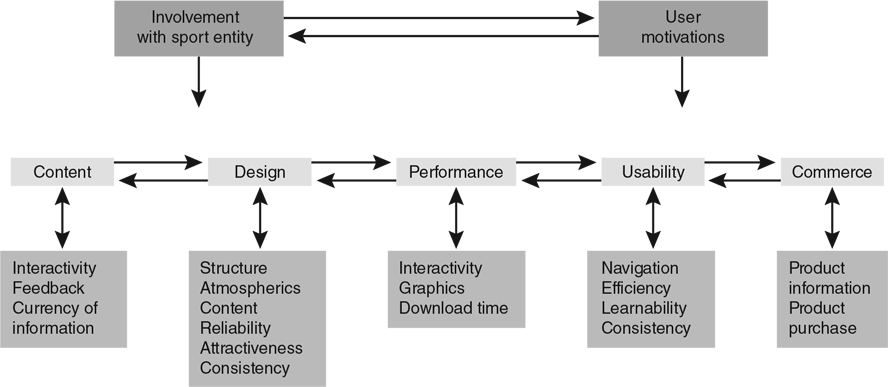Model for Online Sport Communication
This is an excerpt from Strategic Sport Communication 4th Edition With HKPropel Access by Paul M Pedersen,Pamela C Laucella,Edward (Ted) M Kian,Andrea N Geurin.
To fully grasp the nature and scope of online sport communication, the key factors that influence it, as well as the components that are instrumental for success, must be understood. The following subsections address these factors and components by means of the MOSC, which was conceptualized by Kim Miloch of Texas Woman’s University during the research for the first edition of this textbook (Pedersen et al., 2007). Miloch’s original vision for the MOSC revolved around sport organizations’ websites, but today, the scope is broader and includes all online and digital components of an organization, including its social media accounts, mobile apps, and digital video content. Online sport communication is influenced by a myriad of factors, and the MOSC highlights the seven factors considered most pertinent:
- Individuals’ level of involvement with the respective sport entity
- Individuals’ motives for Internet use
- Content of the sport entity’s online media (e.g., website, social media accounts)
- Design of the sport entity’s online media
- Performance of the sport entity’s online media
- Usability of the sport entity’s online media
- Commerce of the sport entity’s online media
The first and second components of the MOSC illustrate the role of people’s involvement with the sport entity and their motives for using the Internet, digital media, or mobile apps. These components are presented first because they form the basis for individuals’ desires, needs, and expectations when visiting a sport entity’s online and digital platforms. In other words, depending on the person’s needs, one of the remaining components may influence the effectiveness of the entity’s communication more than another component. For example, if someone desires to download a podcast, the performance and usability components of the model may be most pertinent to that person. If the podcast takes too long to download, the individual will not be satisfied, and the opportunity for effective and enhanced communication will be lost. In contrast, if someone visits a sport entity’s website to retrieve game statistics for a specific player, then the site’s content, design, and usability components are likely to be most important in the online communication process. This person will want the content quickly, and the website should easily lead him or her to the desired content through its design and usability.
Therefore, the influence of individual motives in the online sport communication process should not be overlooked. These motives influence people’s needs, and online sport communication should address those needs. The remaining five components of the model—that is, the third through seventh components—address the online needs of sport consumers. These five factors are not limited to websites; rather, in today’s ever-expanding technological environment, they also apply to other forms of online communication such as social media, digital videos, podcasts, and smartphone apps.
The first of these five components—which is the third component of the MOSC—focuses on content. A sport entity’s digital communication should deliver content that not only meets users’ needs but also reflects positively on the mission and values of the organization. That said, users desire a range of content, and the sport entity should provide it quickly.
The fourth component of the model reflects the importance of design in online sport communication. Whereas sport entities are bound by the design and interactivity features of social media platforms such as Instagram or X, the design of their own website can influence user interaction. Interactivity differentiates online sport communication from other media, and when integrated well, it can greatly enhance communication with sport consumers.
The fifth component of the MOSC focuses on the performance of online sport communication platforms and the importance of enabling users to access and download certain features in a timely manner. When sport entities rely on third parties to deliver their messages, it is incumbent upon the organization to choose partners that provide a consistent and reliable service. For example, if an organization has its own podcast, it may choose to make it available for download via its own website as well as through third-party applications such as iTunes or Stitcher. The organization must select these third-party applications carefully.
The sixth component involves usability—that is, people’s ability to use the features of the site to gather the desired sport information. If a sport entity’s communication mechanisms are not readily usable, communication becomes much more challenging, and the sport entity struggles to get its messages out to its publics.
The seventh and final component of the model focuses on commerce. The Internet is not only a highly effective communication tool but also one with great potential to promote and market products; the role of online sport communication in marketing the entity is examined as part of this component.
The components of the Model for Online Sport Communication are instrumental in cultivating high-quality communication and helping the sport entity develop an effective online and digital presence. These components are very much interrelated; each affects the others. To illustrate these components, the MOSC is presented in figure 9.2.

SHOP

Get the latest insights with regular newsletters, plus periodic product information and special insider offers.
JOIN NOW
Latest Posts
- Using double inclinometers to assess cervical flexion
- Trunk flexion manual muscle testing
- Using a goniometer to assess shoulder horizontal adduction
- Assessing shoulder flexion with manual muscle testing
- Sample mental health lesson plan of a skills-based approach
- Sample assessment worksheet for the skill of accessing valid and reliable resources


